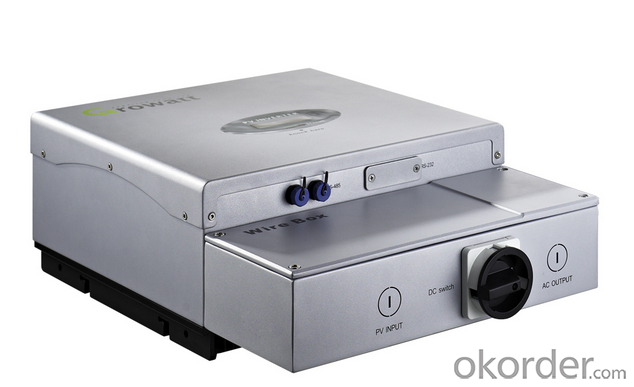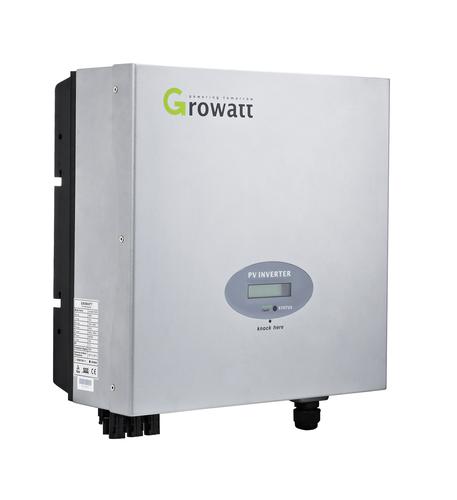Best Rv Solar Inverter 4000W-5000W Grid Connected Solar System
- Loading Port:
- Shekou
- Payment Terms:
- TT or LC
- Min Order Qty:
- 10 pc
- Supply Capability:
- 10000 pc/month
OKorder Service Pledge
OKorder Financial Service
You Might Also Like
Grid Connected Solar inverter 4000W-5000W
Maximum efficiency of 97.8% and wide input voltage range
Internal DC Switch
Transformerless GT topology
Compact design
MTL-String
Bluetooth/ RF technology/ Zigbee/ Wi-Fi
Sound control
Easy installation
Comprehensive Growatt warranty program
Maximum efficiency of 97.8%
wide input voltage range
Internal DC Switch
Transformerless GT topology


Communications
> RS485 /GPRS interfaces
> Computer monitoring software
Safety
> Full protection functions:DC reverse polarity, AC short-circuit protection, ground fault monitoring, grid monitoring, integrate all-pole sensitive, leakage current monitoring unit.
> Standards complied: EN61000-6-1, EN61000-6-2, EN61000-6-3, EN61000-6-4,EN61000-3-2, EN50178, VDE0126-1-1,IEC-62109
Technical Specifications
4000TL | 4400TL | 5000TL | |
| Inputdata | |||
| Max.DCpower | 4600W | 5000W | 5800W |
| Max. DC voltage | 580V | 580V | 580V |
| StartVoltage | 120V | 120V | 120V |
| PV voltage range | 90V-580V | 90V-580V | 90V-580V |
| MPP voltage range/ Nominal voltage | 95V-580V/360V | 95V-580V/360V | 95V-580V/360V |
| Full load DC voltage range | 250V-500V | 250V-500V | 250V-500V |
| Max. input current/ per string | 20A/20A | 20A/20A | 20A/20A |
| Number of independent MPP trackers /strings per MPP tracker | 1/3 | 1/3 | 1/3 |
| Efficiency | |||
Max.efficiency | 97.8% | 97.8% | 97.8% |
| Rated AC output power | 3680W | 4200W | 4600W |
| Max. AC power | 4000W | 4400W | 5000W |
| Max. output current | 16A | 21A | 25A |
| AC nominal voltage; range | 220V/230V/240V 180Vac-280Vac | 220V/230V/240V 180Vac-280Vac | 220V/230V/240V 180Vac-280Vac |
| AC grid frequency; range | 50Hz, 60Hz;±5Hz | 50Hz, 60Hz;±5Hz | 50Hz, 60Hz;±5Hz |
| Power factor | 1 | 1 | 1 |
| THDI | <3% | <3% | <3% |
| AC connection | Single phase | Single phase | Single phase |
| Protection Devices | |||
| DC reverse polarity protection | yes | yes | yes |
| DC switch rating for each MPPT | yes | yes | yes |
| Output over current protection | yes | yes | yes |
| Output over voltage protection-varistor | yes | yes | yes |
| Ground fault monitoring | yes | yes | yes |
| Grid monitoring | yes | yes | yes |
| Integrated all-pole sensitive leakage current monitoring unit | yes | yes | yes |
| Generaldata | |||
Dimensions(W/H/D) in mm | 406/406/192 100% | 406/406/192 21KG | 406/406/192 |
| Features | |||
DC connection AC connection Display Warranty: 5years/10years | H4/MC4(opt) Screw terminal LCD yes/opt | H4/MC4(opt) Screw terminal LCD yes / yes / yes/opt | H4/MC4(opt) Screw terminal LCD yes / yes / yes/opt |
| Certificates and ApprovalsCE, VDE 0126-1-1, DK5940, G83, G59, RD1663, EN50438, IEC 62109, ENEL-Guide |
- Q: What are the potential risks of electrical shock from a solar inverter?
- The potential risks of electrical shock from a solar inverter include accidental contact with live electrical components, inadequate grounding or improper wiring, and failure to follow safety precautions during installation or maintenance. Additionally, poor maintenance, lack of training, or using faulty equipment can further increase the risk of electrical shock.
- Q: What is the cost of a solar inverter?
- The cost of a solar inverter can vary depending on factors such as the brand, capacity, and features. Generally, residential solar inverters can range from a few hundred dollars to a couple of thousand dollars. Commercial-grade inverters can cost several thousand dollars to tens of thousands of dollars. It is recommended to consult with a solar installer or supplier to get an accurate cost estimate based on your specific requirements.
- Q: What are the different power output modes of a solar inverter?
- The different power output modes of a solar inverter include grid-tie mode, off-grid mode, and hybrid mode. In grid-tie mode, the inverter synchronizes with the utility grid and feeds excess solar power back to the grid. Off-grid mode allows the inverter to operate independently from the grid, providing power to a standalone system or battery storage. Hybrid mode combines both grid-tie and off-grid capabilities, enabling the inverter to utilize solar power while still being connected to the grid for backup or additional power supply.
- Q: How does a solar inverter protect against lightning strikes?
- A solar inverter typically protects against lightning strikes by incorporating surge protection devices and grounding systems. These features help to divert the excess energy caused by a lightning strike away from the sensitive electronic components of the inverter, preventing damage and potential electrical hazards.
- Q: Can a solar inverter be used in systems with different module orientations?
- Yes, a solar inverter can be used in systems with different module orientations. Solar inverters are designed to convert the direct current (DC) generated by the solar panels into alternating current (AC) that can be used to power electrical devices. They are compatible with various module orientations, including both portrait and landscape orientations. However, it is important to consider the efficiency and performance of the solar system when installing modules with different orientations, as it may affect the overall energy production.
- Q: How does a solar inverter handle voltage unbalance?
- A solar inverter handles voltage unbalance by continuously monitoring the phase voltages of the grid. If a voltage unbalance occurs, the inverter adjusts its output voltage and frequency to maintain a balanced supply to the grid. This ensures that the solar inverter can efficiently convert the DC power generated from the solar panels into AC power that is synchronized with the grid, despite any voltage imbalances.
- Q: Can a solar inverter be installed indoors?
- Yes, a solar inverter can be installed indoors.
- Q: How does a solar inverter handle high temperatures?
- A solar inverter handles high temperatures by incorporating various cooling mechanisms such as heat sinks, fans, and thermal management systems. These components help dissipate heat generated during the inverter's operation, preventing overheating and ensuring optimal performance even in hot climates.
- Q: Can a solar inverter be used with micro-inverters?
- Yes, a solar inverter can be used with micro-inverters. In fact, micro-inverters are designed to work in conjunction with a central solar inverter. The role of the micro-inverter is to convert the DC power generated by individual solar panels into AC power, which can then be fed into the central inverter for further conversion and distribution to the electrical grid. This combination allows for optimized power production and monitoring of individual panel performance.
- Q: What is the role of a solar inverter in a solar-powered desalination system?
- The role of a solar inverter in a solar-powered desalination system is to convert the direct current (DC) electricity generated by the solar panels into alternating current (AC) electricity that can be used to power the desalination process. The inverter ensures that the energy produced by the solar panels is compatible with the desalination system, allowing it to operate efficiently and effectively.
Send your message to us
Best Rv Solar Inverter 4000W-5000W Grid Connected Solar System
- Loading Port:
- Shekou
- Payment Terms:
- TT or LC
- Min Order Qty:
- 10 pc
- Supply Capability:
- 10000 pc/month
OKorder Service Pledge
OKorder Financial Service
Similar products
Hot products
Hot Searches
Related keywords






























